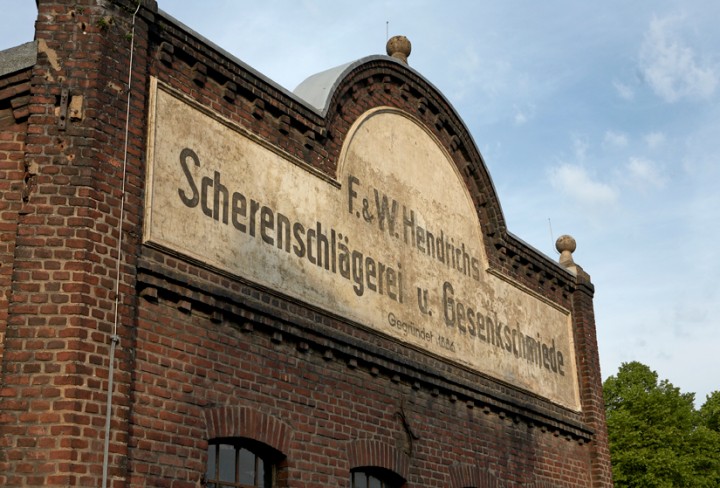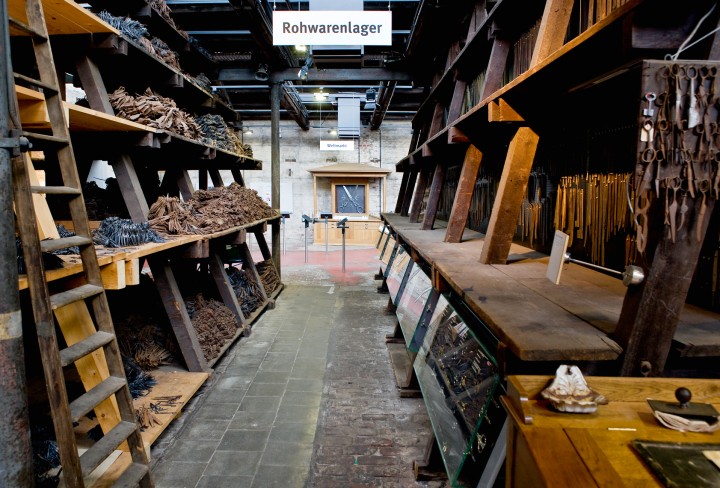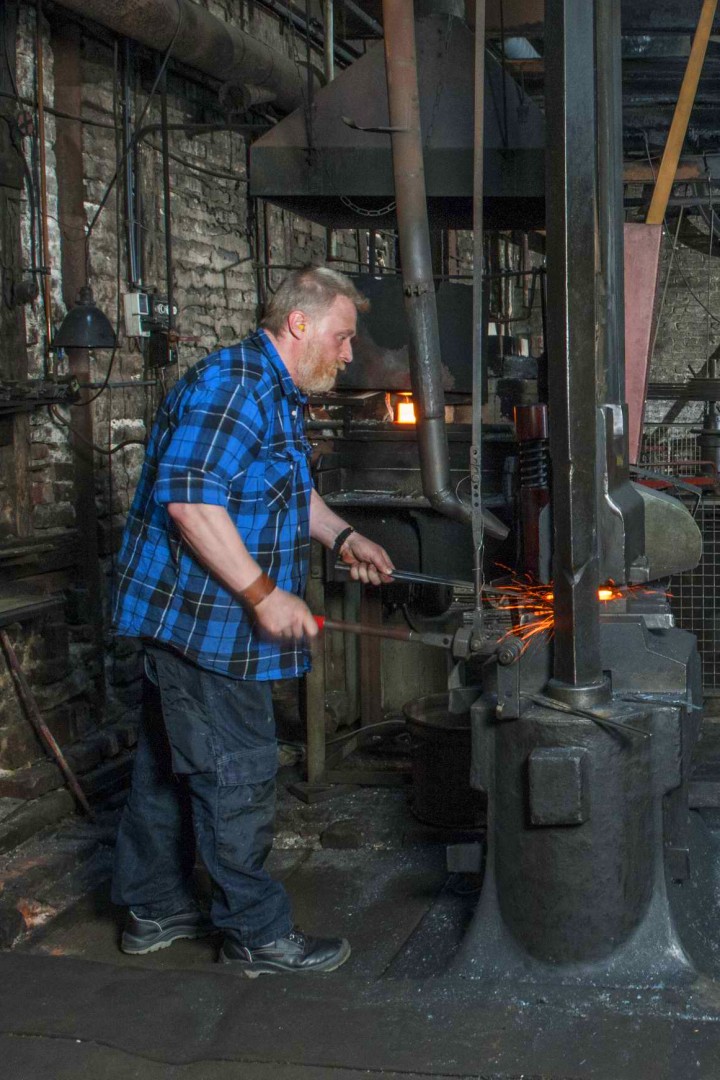Alle Standorte des LVR-Industriemuseums sind vom 23.12.2025 bis einschließlich 1.1.2026 geschlossen.

Solingen. “F. & W. Hendrichs – Scissor manufacturing and drop forge – founded in 1886” – these are the words written on the huge corner front of the LVR-Industriemuseum in Solingen. The old factory site with its buildings made of red brick stones, their typically slanted saw tooth roofs and the high chimneys has barely changed. From 1886 to 1986 scissor blanks were forged here. All the machines, drop hammers, presses and mortising machines, all the tools, as well as the workbenches for the toolmakers, are still existing. Even the changing room with its lockers, the washing room with long rows of revolving washtubs, the engine house or the overseas branch with rattling typewriters - everything is still there. The industrialist family’s villa still stands in its place.
Shortly after the end of manufacturing in 1986, the former drop forge Hendrichs became a part of the LVR-Industriemuseum. It is a very special museum, for here the production is still running: the mechanical belts are humming, the furnaces are glowing and the hammer is pounding. There is still a very special atmosphere, which fascinates and makes one curious. Workers in boiler suits stand in front of the drop hammers and forge scissors. In another room the many tools for the scissor-moulds are worked on in vices. The further processing of the scissors – the hardening, the sharpening and the assembling – is shown in former, still functioning home workshops, which were integrated into the exhibition. Further departments illustrate the mechanization of the sharpening and explain the live and work of the people in the cutlery production.
The elegant factory mansion from 1896 gives the visitors an inside look into the bourgeois world of living of the industrialist family. The museum’s café with its beautiful winter garden is placed in there as well. In summer the gorgeous garden with its old trees invites everybody to dwell.
In the last third of the 19th century, the cutlery-industry in Solingen gained a leading position in the world market. The secret to its success was grounded in a flexible division of labour between the industrial production of the drop forge and high qualified craftsmen and home-workers, who worked independently in their workshops. During this time, the brothers Hendrichs founded the drop forge in Solingen-Merscheid.
Even nowadays, the cutlery-industry still has an important role in Solingen, although the number of businesses clearly decreased. One hundred years after its foundation in 1886, the gates of the company Hendrichs closed as well. Only a few weeks later, the factory gates opened again. Since then the former employees of the company Hendrichs demonstrate the fabrication of the scissor blanks in the museum. In November 1986, the LVR-industrial museum opened parts of the old factory for visitors. The complete re-opening happened in 1999 after a sensitive restoration and inclusion of modern exhibition technology.
More than 3500 square meters are waiting to be explored in Solingen. Elaborated tours give an inside into the subject areas of the museum. In addition, one can choose different tours with special emphasises to be guided through the museum. An extensive supporting programme completes the museum’s offers. Most popular are the guided tours on Sundays, the evening theme tours and the guided tours for children, as well as industrial-historical field trips and factory tours. Lectures, readings and discussions are likewise part of the programme.
The concert series “Jazz in der Schmiede” (eng: Jazz in the forge) or the annual museum’s festival mark the highlights in the calendar of events. Every year in autumn, the MesserGabelScherenMarkt (eng.: KnifeForkScissorMarket) takes place. Here more than 20 companies from Solingen present cutlery for eyerybody’s taste and need in best quality. Three to four times a year, the museum’s supportive association invites everybody to its lectures and talks under the title “Sonndags en der Schmette” in an informal atmosphere. Included in the regular programme is also a sharpening service: Tuesdays and Thursdays the grinding shop is open for visitors who would like to get their worn-out scissors or knifes sharpened for a good price.
The events that happen in cooperation with the Humboldt-Gymnasium, the museum’s partner school, are crowd pullers, as well. For the different types of schools the museum provides diverse educational programmes for all grades. This pedagogic offer is expanded with special activities for children, particularly during the school holidays.
The themes of the permanent exhibition in the former drop forge Hendrichs is appended by a network of industrial-historical points of interest, which the LVR-Industriemuseum built with several partners: In an originally preserved small old cottage, the grinding shop Wipperkotten, visitors can observe the work of a grinder. The Loosen Maschinn is a former steam grinding shop, in which more than 200 grinders sharpened with the power of steam. An originally preserved workshop of Solingen´s home industry can be visited in the Taschenmesserreiderei Lauterjung. In the delivery branch office of the company Herder the genuine furnishing and an exhibition give an impression of the hard work of the female employees. In the old washhouse Weegerhof the visitors can explore a treasure of industrial culture in Solingen – a cooperative association’s laundry with an exhibition about the history of washing.
The droping forge Hendrichs is one of a total of seven exhibition sites of the LVR-Industriemuseum, which combined, create a unique museum. In historical factories, of which some are listed for preservation, the history of the industry in the Rhineland and its workers is told in an interesting and illustrative way. The focus is put on metal, fabrics, paper and electricity, as the local branches. Apart from the droping forge Hendrichs the other museums are waiting to be explored: the Papiermühle Alte Dombach in Bergisch Gladbach, the Kraftwerk Ermen & Engels in Engelskirchen, the Tuchfabrik Müller in Euskirchen, the Textilfabrik Cromford in Ratingen, the Zinkfabrik Altenberg as well as the St. Antony-Hütte in Oberhausen. Furthermore, the museum’s headquarter with management, administration, depositories, library, photo archive and garages is placed in Oberhausen. Founder and bearer of the LVR-Industriemuseum is the Landschaftsverband Rheinland (LVR).
LVR-Industriemuseum
Gesenkschmiede Hendrichs
Merscheider Straße 289-297
42699 Solingen
kulturinfo rheinland
Tel.: 02234 / 9921-555 (Mon-Fri 8 am – 6 p;, Sat, Sun 10 am – 3 pm)
Fax: 02234/9921300
Mail: info@kulturinfo-rheinland.de
Tuesday to Friday 10 am – 5 pm
Saturday and Sunday 11 am – 6 pm
Mondays closed
During the duration of a temporary exhibition, only a combined ticket for the special and temporary exhibition is offered!
Combined ticket (permanent and temporary exhibition): €8
Reduced combined ticket: €6 (students, trainees, people doing federal voluntary service), €5.50 (people with severe disabilities)
Combined ticket for groups of 10 or more: €7 per person
If no special exhibition:
Admission to the permanent exhibition: €7
Reduced: € 5 (students, trainees, federal volunteers), € 4.50 (people with severe disabilities, recipients of benefits SGB II and SGB XII)
Permanent exhibition for groups of 10 or more people: €6 per person, reduced €4 per person (people with severe disabilities, recipients of SGB II and SGB XII benefits)
The following photographs are only to be used for editorial purposes in the context of coverage about the LVR-Industriemuseum and have to be marked with the copyright “©LVR-Industriemuseum”. Their printing is free of charge, but we would like to receive a specimen copy. The usage outside of this context is prohibited.

Corner front of the drop forge Hendrichs. This part of the exterior view was once designed after aesthetic standards.
© LVR-Industriemuseum

View into the former warehouse of the drop forge Hendrichs. Once, thousands of scissors in different forms and proportions were stored there.
© LVR-Industriemuseum
